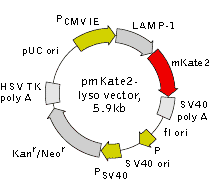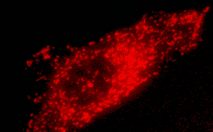
|
||||||||||
|
||||||||||

|
|
||||||||||||||||||||||||||||||||||||||||||||||||||||||
The vector sequence has been compiled using the information from sequence databases, published literature, and other sources, together with partial sequences obtained by Evrogen. This vector has not been completely sequenced. |
|||||||||||||||||||||||||||||||||||||||||||||||||
 Download
|
| ||||||||||||||||||||||||||||||||||||||||||||||||
Vector description
pmKate2-lyso is a mammalian expression vector intended for far-red fluorescent labeling of lysosomes in living cells. The vector encodes far-red fluorescent protein mKate2 (see reporter description) targeted to lysosomal membrane by rat Lysosomal Associated Membrane Protein 1 (LAMP-1), fused to the mKate2 N-terminus.
 | Transiently transfected HeLa cells expressing mKate2 fusion with rat Lysosomal Associated Membrane Protein 1 (LAMP-1). |
mKate2 codon usage is optimized for high expression in mammalian cells (humanized) [Haas et al., 1996].
pmKate2-lyso vector can be used as a source of mKate2-LAMP1 hybrid sequence. The vector backbone contains unique restriction sites that permit its excision and further insertion into expression vector of choice.
Note: The plasmid DNA was isolated from dam+-methylated
The vector backbone contains immediate early promoter of cytomegalovirus (PCMV IE) for protein expression, SV40 origin for replication in mammalian cells expressing SV40 T-antigen, pUC origin of replication for propagation in
SV40 early promoter (PSV40) provides neomycin resistance gene (Neor) expression to select stably transfected eukaryotic cells using G418. Bacterial promoter (P) provides kanamycin resistance gene expression (Kanr) in
Expression in mammalian cells
pmKate2-lyso vector can be transfected into mammalian cells by any known transfection method. CMV promoter provides strong, constitutive expression of the mKate2-LAMP1 fusion in eukaryotic cells. If required, stable transformants can be selected using G418 [Gorman, 1985].
Propagation in
Suitable host strains for propagation in
Location of features
PCMV IE: 1-589
Enhancer region: 59-465
TATA box: 554-560
Transcription start point: 583
mKate2-LAMP1 fusion
Start codon (ATG): 626-628
Lysosomal Associated Membrane Protein 1 (LAMP1) sequence: 626-1846
Start of mKate2 coding sequence (ATG): 1907-1909
Stop codon: 2603-2605
SV40 early mRNA polyadenylation signal
Polyadenylation signals: 2758-2763 & 2787-2792
mRNA 3' ends: 2796 & 2808
f1 single-strand DNA origin: 2855-3310
Bacterial promoter for expression of Kanr gene
-35 region: 3372-3377
-10 region: 3395-3400
Transcription start point: 3407
SV40 origin of replication: 3651-3786
SV40 early promoter
Enhancer (72-bp tandem repeats): 3484-3555 & 3556-3627
21-bp repeats: 3631-3651, 3652-3672 & 3674-3694
Early promoter element: 3707-3713
Major transcription start points: 3703, 3741, 3747 & 3752
Kanamycin/neomycin resistance gene
Neomycin phosphotransferase coding sequences:
Start codon (ATG): 3835-3837
Stop codon: 4627-4629
G->A mutation to remove Pst I site: 4017
C->A (Arg to Ser) mutation to remove BssH II site: 4363
Herpes simplex virus (HSV) thymidine kinase (TK) polyadenylation signal
Polyadenylation signals: 4865-4870 & 4878-4883
pUC plasmid replication origin: 5214-5857
References:
- Gorman C. High efficiency gene transfer into mammalian cells. In DNA cloning: A Practical Approach, Vol. II. Ed. D. M. Glover. (IRL Press, Oxford, U.K.). 1985; 143-90.
- Haas J, Park EC, Seed B. Codon usage limitation in the expression of HIV-1 envelope glycoprotein. Curr Biol. 1996; 6 (3):315-24. / pmid: 8805248
Notice to Purchaser:
mKate2-related materials (also referred to as "Products") are intended for research use only. The Products are covered by U.S. Pat. 7,638,615; European Pat. 1994149; and other Evrogen Patents and/or Patent applications pending. By use of these Products, you accept the terms and conditions of the applicable Limited Use Label License.
|
Copyright 2002-2023 Evrogen. All rights reserved. Evrogen JSC, 16/10 Miklukho-Maklaya str., Moscow, Russia, Tel +7(495)988-4084, Fax +7(495)988-4085, e-mail:evrogen@evrogen.com |


